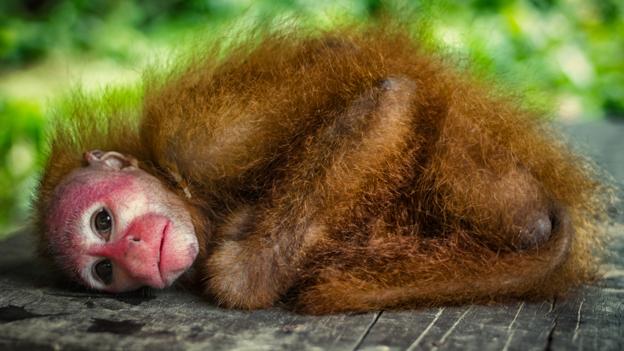The once-endangered uakari monkey is distinctive for its hairless, skull-like face. (Kim Schandorff/Getty)
As 75-year-old villager Antônio Gomes told
us stories of growing up in Boca do Mamirauá, a tiny settlement in the
northern Amazon rainforest, I tried to ignore the tiny blue flies biting through
my trousers. Despite my interest in hearing how locals survive in this remote part
of the Brazilian rainforest, now a part of the Mamirauá Sustainable
Development Reserve, I was grateful to escape
when he finished, finding refuge in one of the tall wooden houses.
The houses hover some 3m above the ground. They
are not unusual: almost everything in the Mamirauá
reserve is on stilts, even the chicken coop. It has to
be. Although much of Brazil is currently suffering one of the worst droughts in
decades, this part of the Amazon is almost completely flooded for the six-month
wet season. By April, the end of the rainy season, the river rises up to 10m high
and overflows its banks. As a result, all living things in the forest,
including locals, must adopt an amphibious lifestyle. Even the jaguars have learned
to adapt by living in tree branches when the floods arrive. Only 1,000 tourists per year are allowed to visit Mamirauá, which, at 57,000sqkm, is the largest wildlife reserve in the country. Created in 1984 to save the once-endangered uakari monkey, the reserve is the most carefully managed and protected part of the Amazon – and is also home to what many consider Brazil’s most successful sustainable tourist resort, the Uakari Floating Lodge. “If [the reserve] had not been created,” guide Francisco Nogeuira said, “the rivers and lakes would be empty of fish, and who knows how many trees would remain today?”
The pirarucu, one of the largest freshwater fish in the world at up to 4m long, is one of the Mamirauá’s main success stories. (In fact, the fish is the main logo for the reserve). Twenty years ago, the species was almost extinct. But after pirarucu fishing was prohibited in most of the reserve’s lakes and an annual quota negotiated, numbers replenished and are now at their pre-1990 levels. Today, only locals who depend on the pirarucu for their livelihood are allowed to fish it. Logging was also made illegal – except to the few locals who need wood for heating and building. With less competition from big-city businessmen and multinational corporations, and with their resources protected in the long term, Mamirauá’s 10,000 riverside residents can once again live sustainably.
Today the rainforest appears limitless, with trees continuing for miles. Almost as expansive as the forest itself is its wildlife: more than 350 types of birds alone, including the prehistoric-looking hoazin and the yellow-rumped cacique, which mimics other wildlife with its call. The limit on tourist numbers means that the impact to the surrounding wildlife and fauna is minimised; even the guided tours of the area include a maximum of 10 people.
The Mamirauá Institute for Sustainable Development, which runs the reserve and the lodge, also steers clear of the Disneyfied aspects of other Amazon tours: there are no dancing tribesmen or performing monkeys. Instead, residents share their knowledge with visitors and are paid for it, from how they cook manioc (a staple root vegetable) to where they catch their fish for dinner. They are employed at Uakari Lodge as cooks or fishing and hiking guides; the institute’s stated goal is that eventually the lodge will be managed purely by the locals. Others aid researchers to track dolphins and jaguars – rather than hunting them. In 2011, tourism activities overall generated an average of R$1,800,000 for each family in the reserve.
Beyond their paid activities, locals took the time to sit and tell me stories about their ancestors who came here from other parts of the Amazon after World War II and the collapse of the rubber industry, looking for work. They invited me into their homes, their schools and their dance halls. I was invited to help pick acai berries and meet their children; when one day I fell ill with kidney pain, they cured me with the bark and sap of a special tree, called “cat’s claws” for its thorns.
Even so, some of the older villagers say life was better before the area became a protected reserve. “We could hunt whatever we wanted and sell the skins. When there were no fish quotas, you could make much more money,” one man in his 70s told me. But most, especially the younger generation, recognise that the changes are vital to protect Mamirauá.
One night, I boated in beautiful Acacio Lake, located 15km north of the lodge. As the sun set, the trees changed from green to black and white, thanks to the flocks of cormorant birds and great egrets that settled in them for the night. In the darkness, the eyes of black caimans – the Amazon’s largest predator – flashed in the torchlight.
Despite the danger, I canoed past these large reptiles into the thick of the forest, where I spent the night in one of the lodge’s tree houses, falling asleep to the melodic sound of rain, frogs and crickets. In the morning, though, I awoke with a shock to roars that sounded like a pride of lions. Thankfully, the noise was only from a group of howler monkeys eager to start a new day.
So was I. And when my five days were up, I found it difficult to leave – biting insects aside. Yet as I said goodbye to Mamirauá, my sadness was soon overcome by the knowledge that the reserve was in safe hands – and my hope that this beacon of sustainable tourism would be a formula admired by many and, perhaps, replicated throughout the world.
























0 comentários:
Postar um comentário